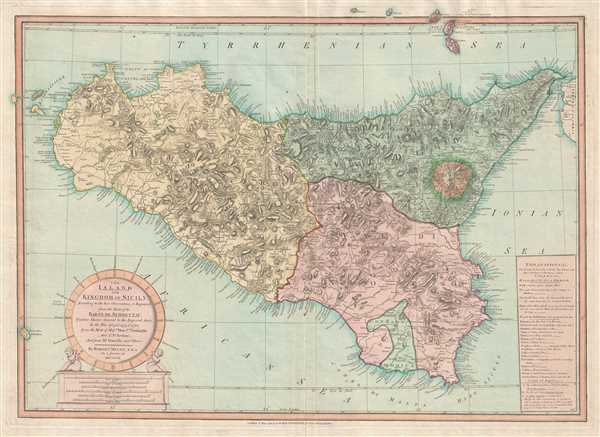This item has been sold, but you can get on the Waitlist to be notified if another example becomes available, or purchase a digital scan.
1799 Mylne and Laurie and Whittle Map of Sicily
Sicily-lauriewhittle-1799
Title
1799 (dated) 20 x 27.5 in (50.8 x 69.85 cm) 1 : 487000
Description
Sicily c. 1799
At the time this map was published, Sicily was embroiled in the French Revolutionary Wars. In order to explain how Sicily came to be a part of France's march across Europe, some historical context is required. In 1799, Sicily was part of the Kingdom of Naples, which had existed in one form or another from 1282 and had changed hands several times. Most recently, a Spanish army had conquered both Naples and Sicily during the War of Polish Succession in 1734, and the younger son of King Philip V of Spain, Charles, Duke of Parma, was installed as the King of Naples and Sicily in 1735. Charles inherited the Spanish throne in 1759 and he left his younger son, Ferdinand IV, in charge of Naples and Sicily. This family was a member of the House of Bourbon (a major European royal house) and as such was a natural opponent of the French Revolution. Ferdinand IV briefly occupied Rome in advance of the French Revolutionary armies but was quickly expelled. Soon afterward Ferdinand fled to Sicily. In January 1799, France established the short-lived Parthenopaean Republic in place of the conquered Kingdom of Naples that was quickly overthrown by a peasant counter-revolution that allowed Ferdinand to return to his capital.
This map was drawn by Robert Mylne and published by Laurie and Whittle in 1799.
CartographerS
Laurie and Whittle (fl. 1794 - 1858) were London, England, based map and atlas publishers active in the late 18th and early 19th century. Generally considered to be the successors to the Robert Sayer firm, Laurie and Whittle was founded by Robert Laurie (c. 1755 - 1836) and James Whittle (1757-1818). Robert Laurie was a skilled mezzotint engraver and is known to have worked with Robert Sayer on numerous projects. James Whittle was a well-known London socialite and print seller whose Fleet Street shop was a popular haunt for intellectual luminaries. The partnership began taking over the general management of Sayer's firm around 1787; however, they did not alter the Sayer imprint until after Sayer's death in 1794. Apparently Laurie did most of the work in managing the firm and hence his name appeared first in the "Laurie and Whittle" imprint. Together Laurie and Whittle published numerous maps and atlases, often bringing in other important cartographers of the day, including Kitchin, Faden, Jefferys and others to update and modify their existing Sayer plates. Robert Laurie retired in 1812, leaving the day to day management of the firm to his son, Richard Holmes Laurie (1777 - 1858). Under R. H. Laurie and James Whittle, the firm renamed itself "Whittle and Laurie". Whittle himself died six years later in 1818, and thereafter the firm continued under the imprint of "R. H. Laurie". After R. H. Laurie's death the publishing house and its printing stock came under control of Alexander George Findlay, who had long been associated with Laurie and Whittle. Since, Laurie and Whittle has passed through numerous permeations, with part of the firm still extant as an English publisher of maritime or nautical charts, 'Imray, Laurie, Norie and Wilson Ltd.' The firm remains the oldest surviving chart publisher in Europe. More by this mapmaker...
Robert Mylne (January 4, 1733 - May 5, 1811) was a Scottish architect and civil engineer, who is remembered for his design for Blackfriars Bridge in London. Born in Edinburgh to a family of architects and builders, his great-great grandfather was the mason and architect Robert Mylne, known for his work as the King's Master Builder at Holyrood Palace in Edinburgh. His father, Thomas Mylne, was the Edinburgh City Surveyor and Deacon of the Incorporation of St. Mary's Chapel, the main mason's guild in Edinburgh. Robert Mylne (the younger) attended the Royal High School from ages nine to fourteen, and then served as an apprentice to Daniel Wright, a carpenter, for the next six years. It is likely that during this time Mylne also learned stonemasonry from his father. In the fall of 1754, Mylne set off on the 'Grand Tour' and joined his brother William in Paris, where he had been studying for a year. They made their way, either on foot or by boat, to Rome, arriving there in January 1755. Mylne was soon studying architecture under the direction of Giovanni Battista Piranesi in Rome, where he studied Ancient Roman aqueducts. In 1757, Mylne accompanied Richard Phelps, a diplomat, and Matthew Nulty, an antiquarian, on a tour of Sicily. He spent the trip producing sketches and measured drawings of antiquities for a projected book, though this work was never published. Mylne won the triennial architecture competition known as the Concorso Clementino in 1758, becoming the first Briton to do so. He left Rome in April 1759 and traveled through Italy and Germany before arriving in London in July. Upon his arrival in London, Mylne learned of a proposal to build a bridge across the Thames River at Blackfriars. The design competition was set to close in October, giving him only three months to submit a design. In February 1760, after a contentious campaign complete with public debate centering around aspects of Mylne's proposed design for the Blackfriars Bridge, he was declared the winner of the competition, besting the designs of several renowned architects. He was appointed surveyor of the new Blackfriars Bridge and given overall responsibility for design, construction, and future maintenance of the structure. After completing the bridge, Mylne would have a long and productive career, though he would not become as well known as his contemporaries Robert Adam and William Chambers. In September 1770, Mylne married Mary Home, with whom he had nine children. Learn More...

